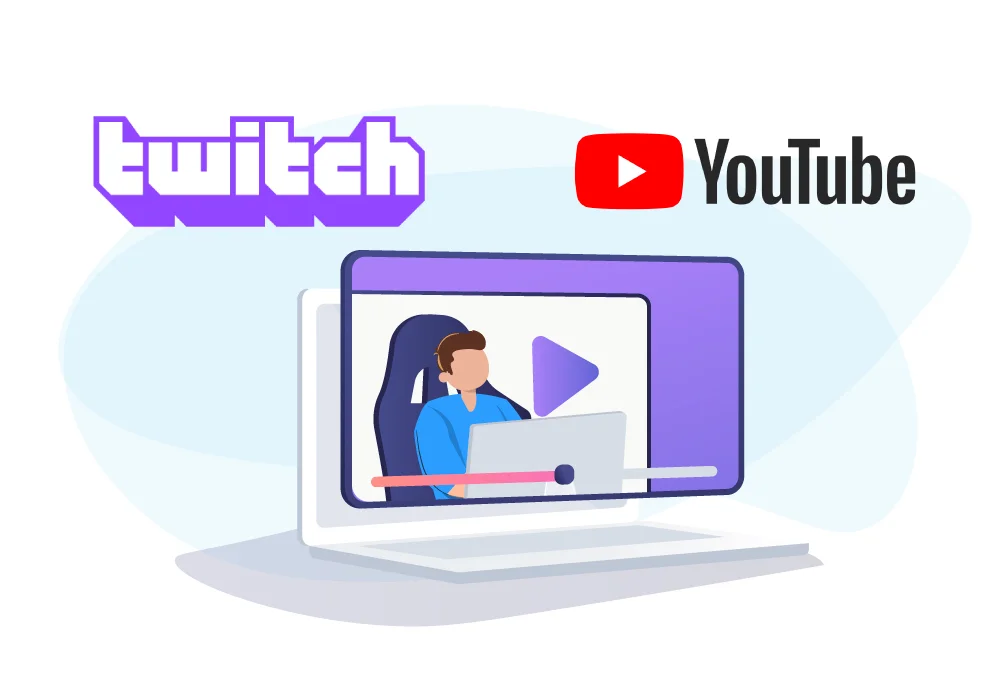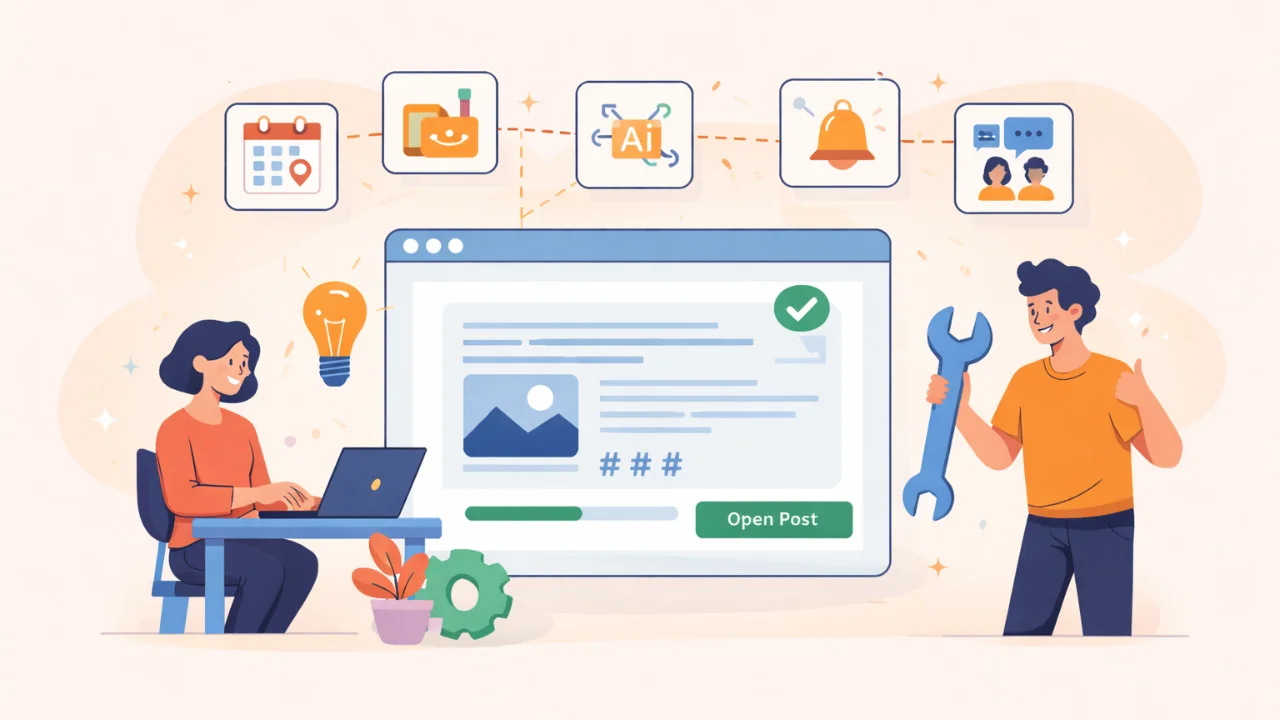Live streaming is currently in high demand as it offers wide-ranging opportunities for topic themes: from the usual gaming and sports to music shows, podcasts, cooking classes, and pretty much anything that can be captured on video and would be interesting to watch. Naturally, content creators are looking for a suitable platform to support the technical side of the stream, and the top two choices are Youtube and Twitch. In this guide, we will compare them for core differences, ease of use, audience, stream quality, and monetization.
What are Twitch and YouTube?
Mostly used for online gaming, Twitch is a live streaming service that has been steadily growing its audience and, as of October 2021, remains the most popular platform among competitors with over 18.5 billion hours watched since January. While there are other content categories present on the platform, gamers constitute its main audience and receive the most attention. Streamers broadcast themselves playing games, usually with an audio commentary, while viewers send comments or emoticons in the chatbox. User donations are enabled to support channel owners.
YouTube as a platform does not need an introduction, and while it is generally used for storing pre-recorded videos, it does have the live streaming functionality and a dedicated section called YouTube Live. On YouTube, content themes are wide-ranging and include vlogs, challenges, educational topics, unboxing, makeup tutorials, product reviews, comedy sketches, etc. There is also a subcategory dedicated to gaming. According to Stream Hatchet, YouTube Gaming has received 3.8 billion hours worth of views so far this year.
The Basic Differences Between Twitch and YouTube
The streaming process implies regularly interacting with the interface: when starting and finishing a stream and for communicating with the viewers during the broadcast. Below are the basic differences between YouTube and Twitch that you should keep in mind.
User Interface and Stream Quality
To start streaming on YouTube, you will need to confirm your phone number within the account settings. The two main ways to go live are on desktop and mobile, with a limitation of 1000 subscribers required for the latter. Desktop streaming supports a higher resolution, multiple cameras, and 360 videos.
For streamers, the interface is quite intuitive and walks you through the process step-by-step. Once you are live, you can monitor the number of viewers, moderate the chat, and monitor comments. For people who are watching, the stream will look like any other video, with the exception of the chatbox being displayed on the right.
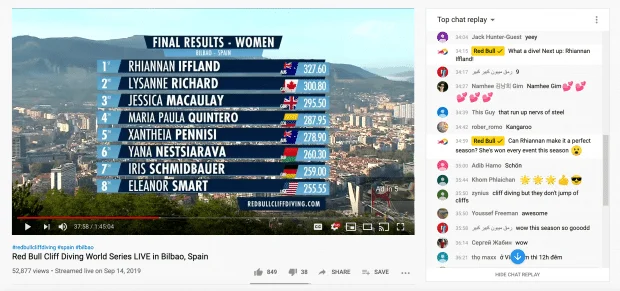
Twitch offers a similar interface with the chatbox on the right side of the video and basic management controls underneath it. However, the navigation can take some time to get used to, especially for the users. Twitch also lacks an important feature that YouTube has: the ability to pause or rewind a live stream. If you pause the broadcast and then hit play again, it will jump to the current moment.
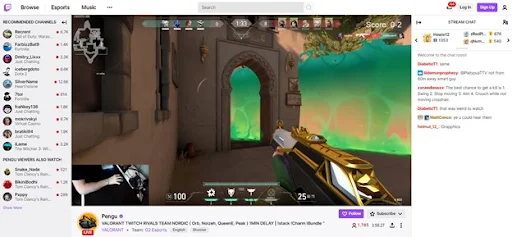
As for stream quality, YouTube users can stream up to 4K (2160p) at 60 frames per second (check out the YouTube video size guidelines), whereas for Twitch, the numbers are capped at HD (1080p) streams at 60 frames per second.
| youtube | twitch | |
| user interface |
|
|
| stream quality (max) | 2160p at 60 fps | 1080p at 60 fps |
Audience and Popularity
In terms of audience and hours-watched numbers, Twitch is in the lead, with 2,1 million concurrent viewers in 2020 and a total of 18,46 billion hours watched. The pandemic has largely contributed to that impressive statistics. As for YouTube, the Gaming segment received 705,9 thousand concurrent viewers and ~ 10 billion watch hours for the same time period. While the difference is evident, YouTube still attracts a significant audience you shouldn’t ignore.
| youtube | twitch | |
| concurrent viewers (2020) | 2,1 million | 0.7 million |
| watch hours (2020) | 18,46 billion | 10 billion |
Chat and Moderation Policies
When it comes to stream chats, the major difference between Twitch and YouTube would be in the message display order. Twitch uses time-based arrangement, and since the rewind and pause feature is not available on the platform, the chat is generally consistent with the events in the stream. On YouTube, by default, messages are ranked for relevance, and viewers can be commenting on completely different parts of the stream at the same time.
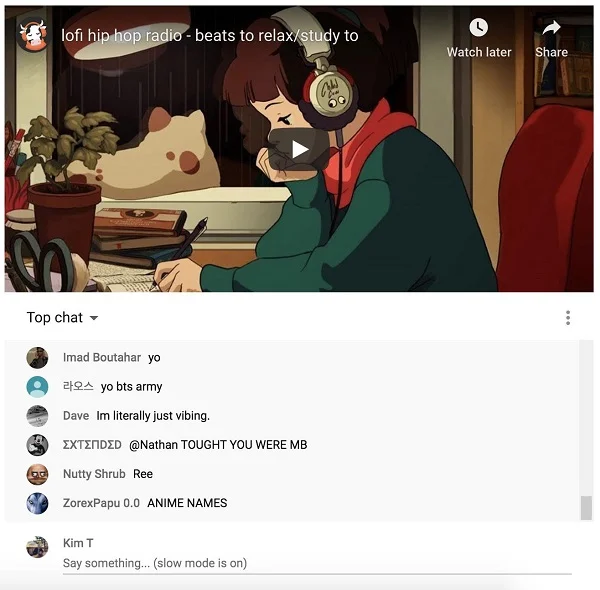
Twitch puts more emphasis on the creative side of the stream, offering platform-specific emotes, which are visual representations of phrases or inside jokes that are custom-designed. Twitch also reinforces chat moderation and its policies are more strict. Both platforms offer the option of assigning moderators to your chat, with Twitch going further and allowing streamers to set their own rules.
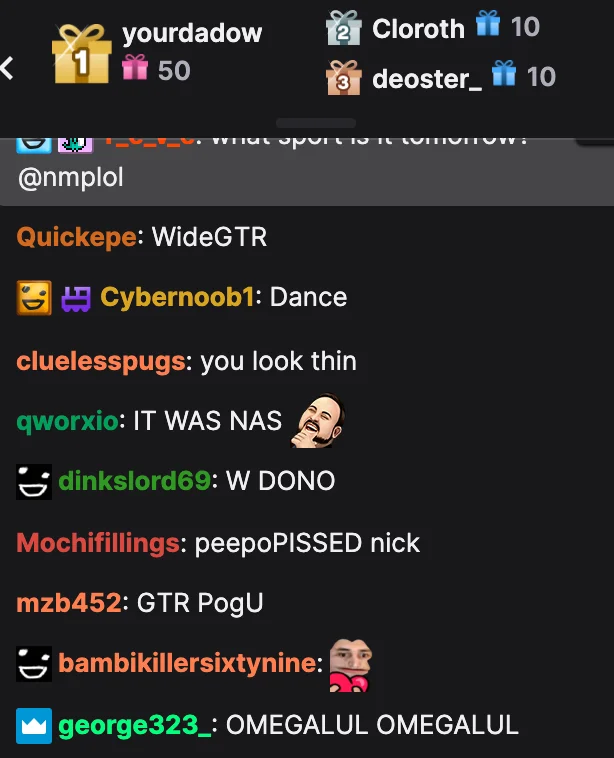
| youtube | twitch | |
| message order by default | relevance-based | time-based |
| moderation | lower standards | higher standards + the ability to create custom chats rules/td> |
| emojis | standard | custom |
The Key Differences Between Twitch and Youtube
The basic differences covered above mainly stem from the history and development of both platforms, with YouTube offering live streaming more as a complementary feature and Twitch basically revolving around it. Getting used to interfaces and chats is inevitable and can be overlooked. Content, monetization, and partnership carry more weight and can have a bigger influence on the platform choice for concerned gamers.
Content
Twitch is mainly a space for gamers, and while it does have different content categories, they are not as specific as the game-based separation for streamers that play in live mode. YouTube’s audience mainly prefers to watch the pre-recorded content of a much wider scope, and there are no extra features to distinguish between different games.
| youtube | twitch | |
| content type | broad | mainly game-related |
Monetization
On each platform, there are several ways to make money, and we will consider them separately.
Twitch Monetization
- Sponsored Advertising
Twitch streams can take sponsorship deals and promote the advertiser’s goods or services during the broadcast or in their profile. It can be merchandise, clothing, or any other product relevant to the content of the stream.
- Inline Ads
Twitch offers the opportunity to display embedded ads that are configured on their side. With this method, you won’t be able to control the type of content that gets promoted through your channel, and as many viewers are likely to have AdBlock, you might not get much out of the agreement.
- Donations
Direct in-app user donations are one of the key differentiators of Twitch vs YouTube. Streamers usually set goals that will help them produce higher-quality content, like getting a new microphone or camera. A receptive audience is often willing to support their favorite channel.
- Paid Subscriptions
Twitch offers the ability to enable paid subscriptions. The cost is decided by the channel’s owner and shared equally between the platform and the creator. Usually, paid subscriptions come with benefits for users, like enhanced quality or custom emoticons.
- Affiliate Program
Similar to affiliate marketing, this type of advertising rewards successful purchases made after users follow the affiliate links. A creator needs to share the special links in their broadcast.
- Sale of Products
Streamers can sell their own products or promote their brand by talking about it during the stream, leaving links in their profile, or sharing ads in the same window as the stream goes. End viewers won’t be able to turn it off or close it like they would with a popup.
- Broadcast Recording
While only holding live events can attract more viewers due to the limited availability, similar to Instagram Stories that disappear after 24 hours, recordings can make a small contribution to video monetization, especially if you place them on YouTube.
Youtube Monetization
- Direct Advertising in Videos
The same as on Twitch, YouTubers are often approached by advertisers for promotion deals and can make a lot of money off of them. You can also reach out to companies and brands yourself.
- Google Adsense Contextual Advertising
These are the video ads that are displayed to viewers before the actual clip. Premium YouTube subscribers and AdBlock users do not see them, so your options for monetization are somewhat limited. To receive your cut of 55% (the rest goes to YouTube), the viewer has to make it past the 30-second mark.
- Partnership Programs
You can work with an agency to make your gaming content more diverse, likable, and technically advanced. In turn, you will be required to share your cut with not just YouTube but the agency as well.
- Selling Your Goods or Services
YouTube is a great platform to sell your own branded merchandise. Through videos, you can convey a message or tell a story, making your image relatable. You should leverage both pre-recorded content and live streams.
- Streams and Donations
While there are no in-app donations, you can create an account on Patreon or a similar platform and place the link in your bio or share it during the stream. Some subscribers might be willing to support your cause, especially if it is tangible and geared towards creating higher-quality content.
- Revenue from Super Chats and Super Stickers
Within the YouTube partner program, you can enable users to purchase highlighted top spots for their messages in the stream chat. The platform will take a 30% cut.
| youtube | twitch | |
| the most promising monetization options | direct and contextual advertising, paid advertising, self-promotion | in-app user donations, paid advertising, self-promotion |
Partnership
Both Twitch and YouTube have an affiliate program that allows them to support creators and make a profit as well, a “win-win” scenario.
Twitch Affiliate Program
There are two different statuses for content creators who want to work with Twitch: affiliates and partners. Both of them have specific threshold criteria for total broadcast time, follower count, concurrent viewers, and some other parameters. The partner status is harder to reach but offers enhanced functionalities and more benefits. In both scenarios, Twitch will take a cut of the earnings.
YouTube Affiliate Program
In the YouTube Affiliate program, different monetization features also have their own criteria in subscriber count and are mostly connected to contextual advertising. There are also extended features like direct access to the creator support team. Creators and YouTube split the revenue gathered from ads.
| youtube | twitch | |
| partnership options | youtube affiliate program harder to qualify | partner and affiliate programs easier to qualify |
Does Twitch Or YouTube Pay More?
It is hard to name any exact numbers as the two platforms end up offering different scenarios of development. With Twitch, you can start making money very soon after you’ve entered the gaming arena: through donations initially, with every successful stream, and then via the Affiliate program. To get a larger income, though, you might have to rely more on your own partnerships with advertisers than on the platform’s algorithms. For YouTube, it is much harder to break into the Affiliate Program, but once you do, the revenue can be very impressive, and each subsequent video will work in your favor, especially if you store the streams and not delete them.
Best Platform for Growth Potential
If you are a gamer who is just starting out, Twitch would be a smarter choice as it has a lenient audience that is more receptive and the platform is more centered around the idea of building a community. Once you get some attention and start making money, you can invest in better equipment and start bringing your loyal subscribers over to YouTube. An important factor to consider here is the geography of your desired audience: YouTube is one of the most blocked websites in the world, completely blocked in China. The best approach for steady growth is to build a presence on both platforms.
Summary
YouTube and Twitch are both strong competitors in the streamer platform market and are better used in unison. Twitch is generally more streamer-friendly, is easier to get started on, and offers more opportunities for quick monetization. YouTube is a well-recognized video giant with a powerful built-in search engine that is likely to continue gaining attention, some of which will inevitably go to its Gaming subcategory.
If your content revolves around gaming and you enjoy the live component of the streams, Twitch would be a more suitable choice. YouTube’s strength is in saving your streams to stay on your channel and monetizing views on them even long after the broadcast is over. Trying out both platforms is the fastest way to figure out which one is more convenient for your specific needs in terms of the user interface, audience, and long-term goals.
